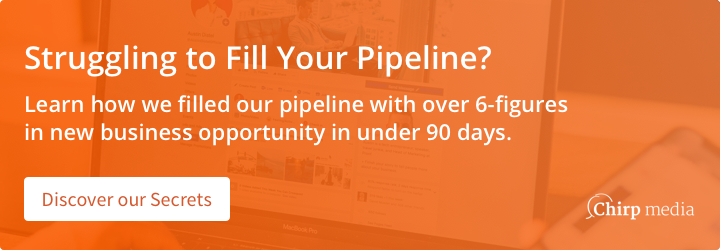How Do You Generate More Leads? 5 Easy Steps to Filling Your Pipeline
First, is asking “how can I generate more leads” the right question? What if you flipped the context and asked yourself, “how much work am I willing to put in”?
We all want more leads at the end of the day, but few of us are actually willing to put in the work. We tend to self sabotage, give up too fast when something doesn’t work within 24 hours, and we doubt every tip or advice that comes our way. It’s simply the society we live in today.
We lack patience when it comes to our long term game plan. Let’s dive deeper into patience and talk a bit about our Sales Enablement process.
What is Sales Enablement?
HubSpot states that sales enablement is the iterative process of providing your business’s sales team with the resources they need to close more deals. These resources may include content, tools, knowledge, and information to effectively sell your product or service to customers.
In under 3 months, a revamp to our process, and an extensive bootcamp series, the team at Chirp learned what sales enablement could do for our business. We were able to fill our sales pipeline with over 6-figures in new business opportunities.
I’m going to take you through our learnings, and share the five simple steps that we took that you could start using today.

Step #1 It’s Time to Leverage Your Network
When was the last time you actually picked up the phone and called up someone simply to connect? See what they’re up to, what they’re doing? Most of all, when was the last time you were actually interested in what they were saying vs. waiting for them to finish so you could pitch your services?
See, when we’re thinking about how to get the next sale, we often forget that there’s a ton of value that can be revealed simply through conversation and listening.
Now this includes social media of course, but let’s not forget those lovely contacts you have saved on your phone. Pick up your phone, no seriously pick up your phone, and ask them for the introduction, or text them! Either way, it’s a conversation.
Now when it comes to social media there are several different ways you can leverage your network.
One action is to tag people you know; a prospect, a colleague, or even someone you want to connect with (yes, you don’t even have to know them) and yes, I’ve done this. What you’re doing here behind the scenes is tapping into their network. The way social media algorithms work, when you tag someone it creates the opportunity for their audience and their network to see what you’ve shared.
One important note, be sure your “ask” is specific. Don’t be vague. We’re already so inundated with people selling us, we don’t want to have to figure out what you’re asking too, so be specific. Two, don’t be selfish. Ask how you can help them or invite others to reach out to you versus telling them to do so. It’s sales, but more humanized, and a softer approach that’s probably more palatable for your audience.
If you’re not the most socially savvy person, it doesn’t matter, tag someone who is. I’m sure there’s at least one person in your network whom you deem as a social guru. If not, tag us, we’d love to engage and further the conversation with you..
And that’s it, super simple.
Remember, once the leads come in, it’s YOUR job to follow up and work them. So, turn those notifications on!

Step #2: Segmenting Your Email List
Don’t over complicate this step. The intention is simply to define who you’re talking to, which of your products or services they might be interested in or are a best fit for, and how you can help them.
Sorting through your list will help guide you in creating the conversations you need to have with the right contacts, so you don’t exhaust your list with every single offering you have. Ultimately this helps your business gain more clarity to who you’re selling to, what products/services you’re selling, and what your audience thinks about your business. It’s part sales and part market research.
You don’t need a big list for this to work, you can sort with as little as 20 contacts. Don’t let the size of your email list be an excuse not to take action.
Let’s use business coaching as an example. We’ll have accountability coaching and action/sales coaching as our products with say 50 contacts.
Let’s take a closer look at how this would play out.
50 Total Contacts
- 15 are people or customers that you’ve lost in touch with
- 5 are leads that you are actively working
- 20 are subscribers to your blog or follow you on social media
- 10 are people who have shown interest in the past, but maybe went cold.
Right there, you can create a new campaign to re-engage with the 15 contacts you’ve lost touch with.
Don't be afraid if you get some unsubscribes.
Remember, it’s much easier to close a sale from someone who’s already engaged with you and are bought in than trying to convince someone of why they should work with you.
As for your loyal subscribers who are actively engaged with you; such as reading your emails, commenting on your social posts, it’s time to put in the ask if you haven’t already done so. Ask them for an introduction, perhaps it’s a quick 15-minute consultation with you where they can ask you one business related question and you answer for free. Hook them in by providing real value upfront and if they’re hungry for more, book a follow up meeting (this one could be paid or whatever you choose, it’s your sales process).
Again, we can only provide you with a guideline, ultimately, you’re the one who’s got to be willing to take on the work to create sales. We can’t do it for you.

Step #3: Know Your Numbers
When it comes to sales, it’s all about numbers at the end of the day. Your objective is to find out what your baseline is.
This includes the revenue you need to generate on a monthly basis to keep the lights on and how much you’d like to pay yourself, but most importantly, knowing our numbers allows us to plan for the work that’s cut out for us.
All right let’s dive into some simple questions to start.
- How much revenue do you need to generate in a month?
- How much do you need to pay yourself monthly? (Gross & Net)
- What are your net profit margins? (Cost to do business vs your take home)
- How many leads do you need to close a sale? (Conversion Rate)
- How many sales do you need per product?
- What is the time required to get one lead?
- Do you have the capacity to schedule in business development time or do you need to bump up the prices of your offerings?
Getting the answers to the questions above is what will give you the beginning framework to calculating your baseline.
For example, if we need to generate $30,000 a month and each of my offerings is $10,000, I know I need to make three sales. If my conversion rate is 25% (most are between 20%-28%) then I know I need to meet with 12 new leads a month. Now the trick question is, how do I get those leads right?
It’s great that we’re always talking about leads but what happens when you don’t have any coming through the doors? Well, simply put, what efforts are you doing to reach out to people? No matter how great our service offerings are and how much we can help people, they don’t owe us anything. If we want the business, we’ve got to be willing to put in the work to get it.
For our team at Chirp, video connect calls work really well and generally for every 20 prospecting videos we send out, that translates into an average of about 15 leads ready to connect and talk business.
Lastly, don’t forget to track and save your progress. Whether it’s in your trusty notebook, an excel spreadsheet, or your robust CRM (more on this later). Take the time to review what you’ve accomplished or didn’t accomplish each month so you know where to focus your efforts in the next month.

Step #4: Find the Tools that Work for You
Technology works wonders when used as a part of your process that buys you more time.
Our team uses a combination of HubSpot, Vidyard, Zoom, ClickUp, and Slack. These tools support us with project management, video/web conference meetings, and sales & marketing automation.
That being said, you have to find what works best for you. Are you more comfortable perhaps on the phone versus videos?
Ultimately, do what works best for you and your sales process, everyone is different.

Finally, Step #5: Accountability & Structure
When it comes to accountability, what we’ve discovered is that it takes commitment, and that commitment has to come from you. No one can make you do something you don’t inherently want to do. And, the biggest inhibitor is fear.
When you find that you’re lacking accountability, the best questions to ask are “what am I avoiding” and “what are my fears surrounding the actions I need to take”? Seriously, if you’re the accountability partner, fight tooth and nail for that person, otherwise, why be their accountability partner?
Accountability is more than just words, it’s an action and a commitment that you will hold the other person to what they say they’re going to do.
Our tip, don’t aim for perfection, simply start. You won’t know how to do better if nothing is done. You won’t know what works and what doesn’t work if you’ve never put in the work to try anything. We’ve learned that it’s all about Failing Faster.
For example, my personal 2020 objective is "am I willing to do what it takes?". Goals are great to set but they mean little when no action is taken. So beyond “goals” in everything I set out to accomplish this year it all circles back to one question, “what am I willing to do to make it happen".
Again, find what works for you.
So, What’s Next?
There you have it, we’ve covered off our 5 steps to our Sales Enablement process that drove over 6-figures in new business opportunities in under 3 months.
From leveraging your current network, working with the current contacts you have, using readily available free online resources, putting in real work to determine your baseline for sales, and find someone who you trust to keep you accountable. You can do this too, but what actions are you willing to do to get there?
You’ve got all the free resources available to start, all you have to do is simply start.
If you say you’re ready to generate more leads, then start today.
Leave us a comment if you have any questions or sign up for Sales Enablement Series for more in depth tips.

Article by Queenie Wei
Queenie loves to challenge the status quo, whether in social media or social change, she is always on the hunt for more efficient ways to optimize existing structures. As part of the 2017 cohort for Global Student Entrepreneur Awards and the 2019 cohort for Startup Canada’s Global Entrepreneurs Challenge, Queenie (the Chaos Harmonizer) loves to explore boldly and implement change on a global scale.





